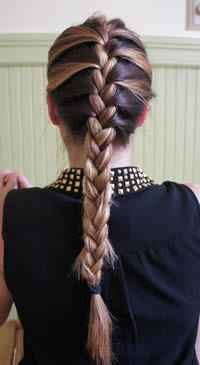Difference between a French Braid and a Braid
Key Difference: A braid is one of the most classic typed of hairstyles, one that has been around for centuries, if not longer. It refers to hair that has been divided and woven into a crisscross pattern. A French braid is a type of braid that starts at the top of the head and adds sections of hair from the sides to the original braid.
 A braid is one of the most classic typed of hairstyles, one that has been around for centuries, if not longer. The term braid refers to materials, such as threads of silk, cotton, or even other material that are woven into a decorative band. This also applied to hair, where the hair would be divided into sections, most commonly three, and interwoven to make a pattern. This is the most basic type of braid.
A braid is one of the most classic typed of hairstyles, one that has been around for centuries, if not longer. The term braid refers to materials, such as threads of silk, cotton, or even other material that are woven into a decorative band. This also applied to hair, where the hair would be divided into sections, most commonly three, and interwoven to make a pattern. This is the most basic type of braid.
However, as it often happen, once people figure something out, they start building up on it, so they start building up on the braid as well. People played with variations and different techniques, such as different ways to weave the hair, or different styles of parting the hair, etc. Eventually, various styles developed out of a simple braid, such as French braid, Dutch braid, fishtail braid, etc.
Fun fact, French braid is not French at all, in fact it is believed to have been developed in North Africa, or Algeria to be exact. Yet somehow down the line, it got associated with the French. A French braid, as it is now popularly known , is similar to the regular braid, but with slight modifications.
A French braid starts at the top of the head, whereas a regular braid can start anywhere. Typically, a regular braid starts towards the bottom of the head, at or near the nape of the neck.
 In a regular braid, the entire hair is taken and separated into three sections for use. However, in a French Braid, only a medium sized section is taken from the top of the head. This section is then further divided into three sections and the braid starts off like a regular braid, being interwoven into a crisscross pattern. However, with each weave, a section of hair is taken from leftover hair on the side, and added into the braid.
In a regular braid, the entire hair is taken and separated into three sections for use. However, in a French Braid, only a medium sized section is taken from the top of the head. This section is then further divided into three sections and the braid starts off like a regular braid, being interwoven into a crisscross pattern. However, with each weave, a section of hair is taken from leftover hair on the side, and added into the braid.
This technique gives the braid a completely different look, with the braid running along the back of the head, something that did not happen with a regular braid. Nonetheless, both types of braid fall in the back of the head and depending on its length will rest against the back.
Comparison between a French Braid and a Braid:
|
|
French Braid |
Braid |
|
Also known as |
French plait |
Plait |
|
Definition (Oxford Dictionaries) |
A woman's hairstyle in which all the hair is gathered tightly and pulled back from the forehead into one large plait down the back of the head. |
Threads of silk, cotton, or other material woven into a decorative band for edging or trimming garments. A length of hair made up of three or more interlaced strands. |
|
Style |
Runs down the back of the head |
Varies, different regions braid hair differently |
|
Top of the head |
Typically starts at the top of the head |
May or may not start at the top of the head. Typically starts at the crown of the head. |
|
Technique |
A medium-sized section of the hair, leaving extra on the sides is taken and divided into three sections, which are then interlaced to a crisscross pattern. On each cross, a section of hair is added from the sided into the braid. |
The hair to be braided is divided into three sections, the three sections are interlaced to create a crisscross pattern |
|
Size |
The braid is thinner or the top and gets thicker towards the bottom as more and more hair is added. |
The braid is thicker on top with all of the hair and usually gets thinner towards the end as the hair thins out. |
Reference: Oxford Dictionaries (French Braid and Braid), Wikipedia (French Braid and Braid), 2 Good to Lose (French Braid and Braid), PopSugar Image Courtesy: ebay.com, instructables.com









Add new comment